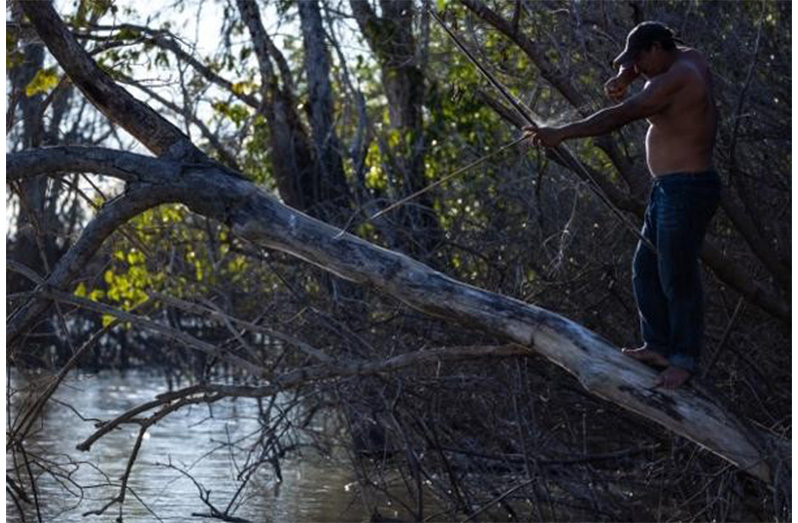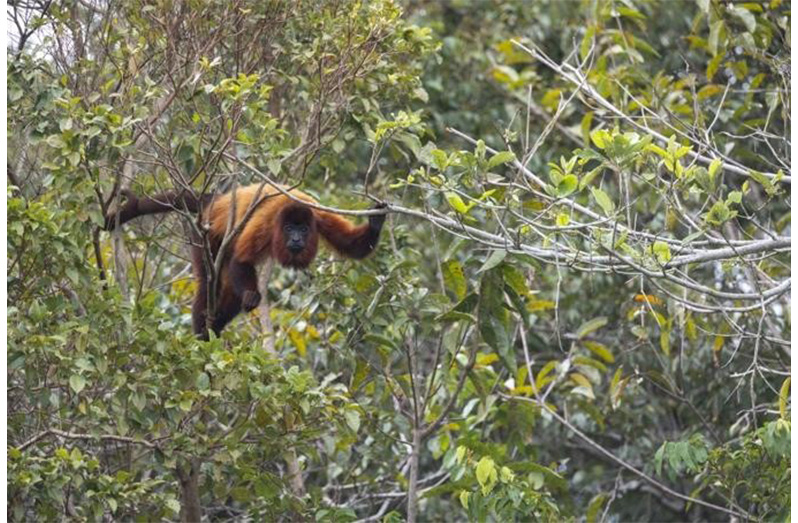SUSTAINABLE Wildlife Management (SWM) Programme Country Project Coordinator, Oswin David, is enthusiastic about his job, supporting colleagues in the Rupununi region with his input on fish and wildlife conservation, which plays a critical part in Indigenous culture and diet.
David added that the SWM Programme in Guyana is encouraging coordinated, community-driven initiatives that support food security and traditional livelihoods. These will contribute to maintaining healthy fish and terrestrial wildlife populations.
David told Pepperpot Magazine that he is originally from Maruranau, South Rupununi, and has been employed with the SWM Programme Guyana for the past seven years, since the organisation’s inception.

David stated that he graduated from the University of Guyana (UG) in 2012 with a degree in Environmental Studies and Science Conservation.
“I am quite patriotic and an environmentalist who loves the outdoors. Adventures and hiking are a must for me. The best way to protect the environment is to make people fall in love with it. Conservation is not just about policies and regulations, but also about inspiring a love for the natural world in individuals,” David said.
He reported that the SWM Programme is a major international initiative that aims to improve wildlife conservation and food security.
“We are developing innovative, collaborative and scalable new approaches to conserve wild animals and protect ecosystems, whilst at the same time improving the livelihoods of indigenous peoples and rural communities who depend on these resources,” he said.
David added that the programme is funded by the European Union (EU), with co-funding from the French Facility for Global Environment (FFEM) and the French Development Agency (AFD).

He revealed that it is currently implemented in 165 countries across the world, by a consortium partnership which includes the Centre for International Forestry Research and World Agroforestry (CIFOR-ICRAF), the Food and Agriculture Organisation of the United Nations (FAO), Wildlife Conservation Society (WCS), and the French Agricultural Research Centre for International Development (CIRAD).
Breaking down the programme
David added that in Guyana, the SWM Programme is implemented by CIFOR-ICRAF in close collaboration with the Guyana Wildlife Conservation and Management Commission (GWCMC), with support from local civil society organisations and community representative groups.
He revealed that the first phase of the programme has just been concluded, spanning five years (August 2018 – July 2023), and a three-year second phase commenced in August 2023. However, the project will be extended from August 2025 to July 2026, with additional funding secured.
David said the model promoted by SWM in Guyana fosters co-management models for inland fisheries and terrestrial wildlife in indigenous biocultural landscapes. The project aims to ensure that the Rupununi region (Administrative Region 9) can continue to provide sustainable options for food security and livelihoods that align with traditional lifestyles.
“Simultaneously, it aims to maintain healthy wildlife populations through integrated sustainable co-management models. This can inform a national-level scale-up, which will also serve as an example to neighbouring Caribbean and Amazonian countries,” he said.

David stated that the SWM Programme model in Guyana follows a community rights-based approach (CRBA) adapted to the sites so that local and Indigenous communities are:
- Ensured equitable participation and inclusion in all project activities;
- Empowered in their legal use and sustainable management of natural resources; and
- Strengthened in their capacity to manage and benefit from wildlife.
The approach is based on five principles and tools:
- Community rights situation analysis;
- Free, Prior and Informed Consent (FPIC);
- Six-step approach to achieving gender equality and empowering women;
- Research ethics;
- Grievance redress mechanism (GRM).
He noted that the project supported the implementation of the first co-management model for inland fisheries by communities in the North Rupununi since 2019, with support from the North Rupununi District Development Board (NRDDB).
Additionally, a Fisheries Management Plan was created for ten riverine villages in North Rupununi to manage fishing activities over 386 km of rivers, including the Essequibo, Rupununi, and Rewa rivers.
He noted that the primary goal of the Fisheries Management Plan is to maintain the sustainability of the fisheries in the North Rupununi wetlands and ensure healthy fish stocks for future generations. The first implementation phase (2019–2021) involved assessing and monitoring fish stocks, conducting a baseline assessment of the fisheries sector in the ten communities, and implementing an awareness-raising project to promote good fishing practices.
The outgoing environmentalist told Pepperpot Magazine that, in 2022, the management plan was revised to align it with the revised Inland Fisheries Policy and with recommendations for the amendment of the Inland Fisheries Act.
However, in 2023, the new Fisheries Management Plan for the North Rupununi was validated by community members and includes a special section on Arapaima management.
David reported that the project also facilitated the consolidation of the wildlife management committee of the Wapichan territory and the development of the Wapichan Wiizi wildlife management plan in the South Rupununi (21 communities).
He said the Wapichan Wiizi Wildlife Management Plan functions as a general 10-year framework produced by the collective villages of the South Rupununi District Council (SRDC) and their local partners to manage “water animals”, “terrestrial animals”, and “flying animals” that are important for Wapichan culture.
His vision
David reported that this plan suggests that villages are to establish rules for all uses of wildlife, including the meat and pet trade. It has contributed to empowering and training local communities and their representative institutions in the development of village-level guidelines for the use of wildlife in 12 communities, as well as to the first phase of implementing innovative management models, such as the Giant Anteater Community Conservation Zone and the Red Siskin Community Conservation Zone.
He pointed out that the project also supported a biocultural assessment in the Karaawaimin Taawa, a traditional hunting and fishing ground now threatened by the expansion of mining. The management plan also included a wildlife monitoring component, utilising camera traps, as well as an assessment of the impacts of roads, bushfires, and human-wildlife conflicts.
A checkpoint was established in South Rupununi as a collaboration among the Shulinab Village Council, the South Rupununi District Council (SRDC), and the GWCMC to control illegal activities in the Wapichan Wiizi territory, particularly regarding wildlife trade.
Finally, the implementation of the plan also involved an ambitious environmental education programme, including in-school curriculum, citizen science, and after-school training in traditional knowledge skills.
In addition, the project helped upscale river turtle conservation initiatives at the regional scale. The Regional River Rupununi Freshwater Turtle Management Plan concerns the Rupununi region as a whole but focuses more specifically on 15 riverine villages along the Rupununi River which are highly dependent on aquatic species for their livelihoods and cultural identity, he said.
David related that the plan aims at recovering river turtle populations of six species present across the Rupununi and explores sustainable options. Prior to the project, one conservation initiative for freshwater turtles had been pioneered by Caiman House Inc. (CHI) in Yupukari village. During the project, river turtle conservation was replicated and adapted to four other communities (Sand Creek, Apoteri, Katoka and Rewa) with support from the South Rupununi Conservation Society (SRCS) and Caiman House Inc. (CHCI).
He pointed out that based on the early success of these initiatives, more communities requested to join the initiative and, in September 2022, it was proposed that the management plan should be a regional management plan, inclusive of all 15 riverine communities from the region, to ensure larger-scale impacts for the benefit of the Rupununi as a whole.
“One of the major achievements of the SWM Programme has been the consolidation of capacities vested in local institutions involved in the management of wildlife. In total, four civil society organisations and two indigenous community groups representing communities at the district level were consolidated. The project supported them with strategic planning, staffing, management and financial skills, and various technical expertise.
In addition, to ensure that these local institutions could better interact with, and influence, national policies, the project also facilitated the signing of memoranda of understanding (MoUs) between these local organisations and national government bodies; for example, Rupununi Livestock Producers Association (RLPA) and the Guyana Livestock Development Authority (GLDA), Visit Rupununi (VR) and the Guyana Tourism Authority (GTA), NRDDB and The Fisheries Department, Ministry of Agriculture (MoA), the SRDC and the GWCMC. Another notable achievement was the successful handing over of the One Health Platform to the GLDA, marking a significant step towards a national implementation, surveillance, and response system to help Guyana better prepare for diseases that can spread from wildlife to humans,” he said.
David stated that in Guyana, the first phase of SWM was directed towards empowering local communities and grassroots groups involved in wildlife management, as well as consolidating management models at the biocultural landscape level.
He related that, as a follow-up, the second phase represents a unique opportunity to consolidate these landscape-level management plans through strengthened village-level governance structures and institutionalised links with relevant governmental structures, following the co-management logic.
In addition, CIFOR-ICRAF through the SWM Programme has created the “Biodiversity Component” project to test and compare six methods: camera trapping, acoustic monitoring, environmental DNA (eDNA), fish stock assessments, bird counts, and Traditional Ecological Knowledge (TEK). Communities can utilise the recommended methods and indicators to monitor their biodiversity, inform decision-making, create village sustainable plans, and contribute to acquiring biodiversity credits.
This second phase seeks to create avenues to ensure the sustainability of these efforts in the long term through sustainable business models.



.jpg)








